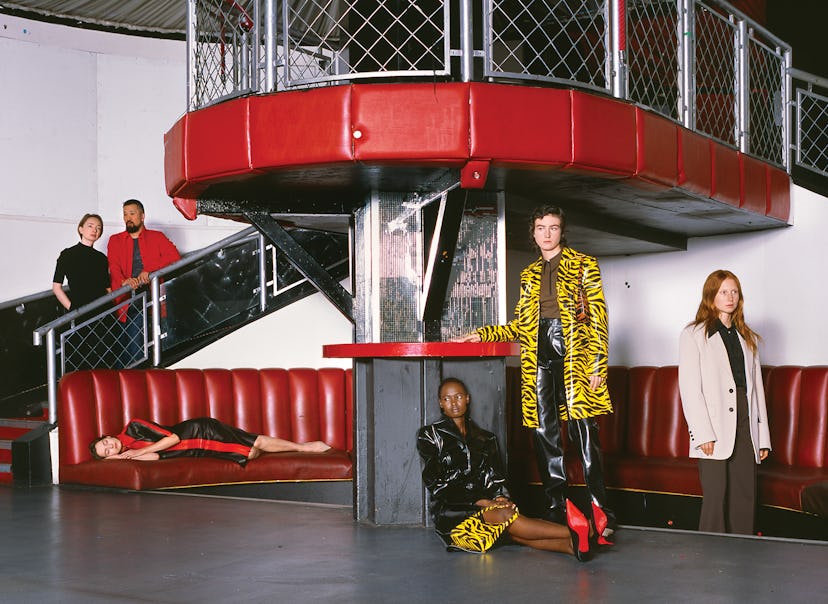Get to Know Kwaidan Editions, the Fashion Brand Making High Concept Clothes With No Fuss
Combining classic references with over-the-top prints and materials, Kwaidan Editions is taking fashion by storm.

Léa Dickely and Hung La, the couple behind Kwaidan Editions, speak thoughtfully, laugh easily, and casually reveal details that betray an unconventional nature. Take, for instance, the way they describe their home in West London. It’s bright, with big windows and a nice view—but decorated with not much more than an array of plants and a fat-lava lamp from the 1970s, found on eBay. “We don’t fuss,” La says. “We always play between the substantial and the bizarre, and leave excess to other people.”
That is also the formula for their success. Their clothes, which riff on opposing forces—masculine and feminine, chintzy and streamlined—are unsettling and seductive, and have resonated deeply with the fashion world. Their fall collection, which plays with the idea of being both visible and invisible, began with a marathon of spy movies, followed by a deep dive into the photo archives of the Stasi, East Germany’s intelligence agency during the Cold War. “They were all about disguising themselves and disappearing,” Dickely says. “You see a lot of beige.” But if there are times when a woman wants anonymity, there are also plenty of moments when she’s eager for attention. Thus the couple returned to their teenage years—their most stylistically expressive—pulling post-punk and rave-culture references. The result: drab overcoats and muted blazers; plastic tiger-print skirts and psychedelic second-skin tops.
Since launching the label in 2016, La, 41, and Dickely, 35, have secured top retailers like Ssense, Net-a-Porter, and Barneys New York; earned a spot among the finalists for the 2018 LVMH Prize for Young Fashion Designers; and—especially thrilling for the pair—collaborated last year with the French artist Dominique Gonzalez-Foerster, whose work Dickely discovered at art school in Reims, France. “They say you never want to meet your heroes,” Dickely says. “But we connected right away; we spoke the same language.” Together, they conceived a presentation that featured Gonzalez-Foerster, disguised in a curly bouffant and a clear Kwaidan Editions trenchcoat, singing in French and German as models danced in cool, clinical looks.
La, an American of Vietnamese descent, met Dickely, who was raised in the Alsace region of France, at the Royal Academy of Fine Arts in Antwerp in 2004. They bonded over, among other things, their love of visually arresting films—beginning with The Shining, which they watched on their first date. La went on to work at Balenciaga and Celine, where he oversaw leather and furs; Dickely consulted on prints and textiles for Alexander McQueen and Rick Owens. Wanting to take their lives into their own hands, as La puts it, they quit their jobs four years ago and started Kwaidan Editions shortly thereafter. The name is a tribute to Masaki Kobayashi’s 1965 cult film, which comprises several eerie folk stories. “It just resonated with us,” La says. Like film directors, La and Dickely begin each collection with a storyboard of sorts. “A set, a place, a mood—the beginning of a story, a premise of something,” Dickely adds.
For all the esoteric references, what makes Kwaidan Editions so appealing is its accessibility. The designs may originate from strange sources, and they are often cut from peculiar materials or embellished with lurid prints, but they are totally familiar when it comes to shape. Tailored trousers, crisp men’s shirting, lean knit dresses, and natty coats are recurring staples. “We like to make clothes that are wearable, and we use that as a constraint,” La says. Perhaps that’s why so many guys have been buying their clothes—so much so, in fact, that the two are thinking of expanding into men’s wear. Furniture, tapestries, and a fragrance are further down the line. “We’ve always talked about creating a space filled with clothes and objects and sounds in which people could live,” La says. “At least for a moment.”